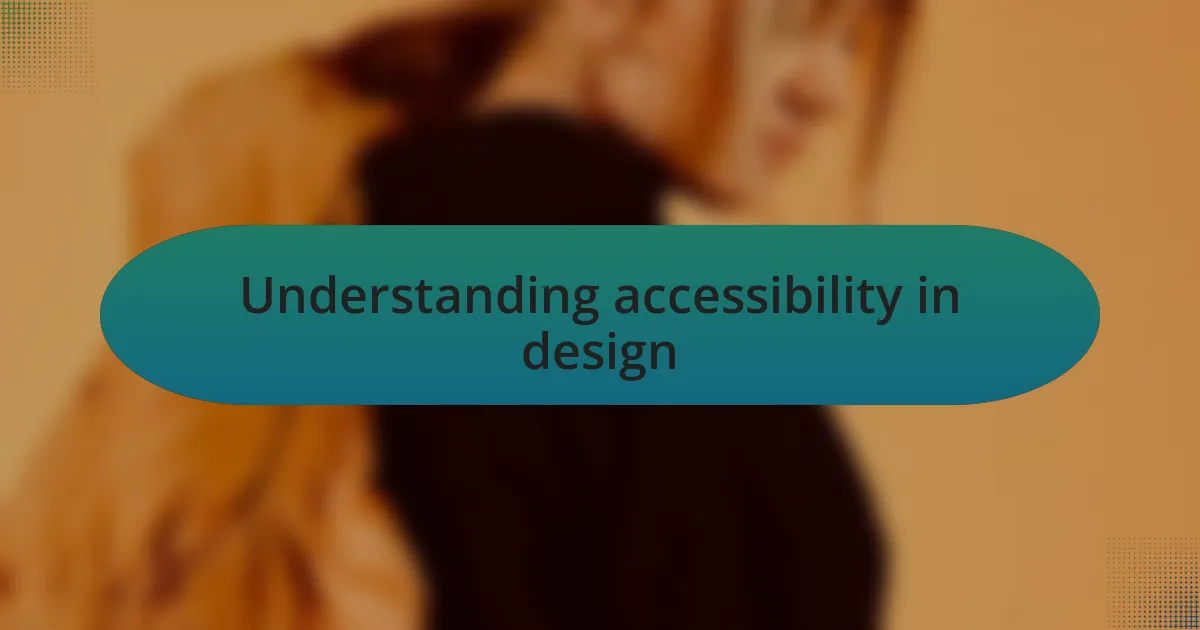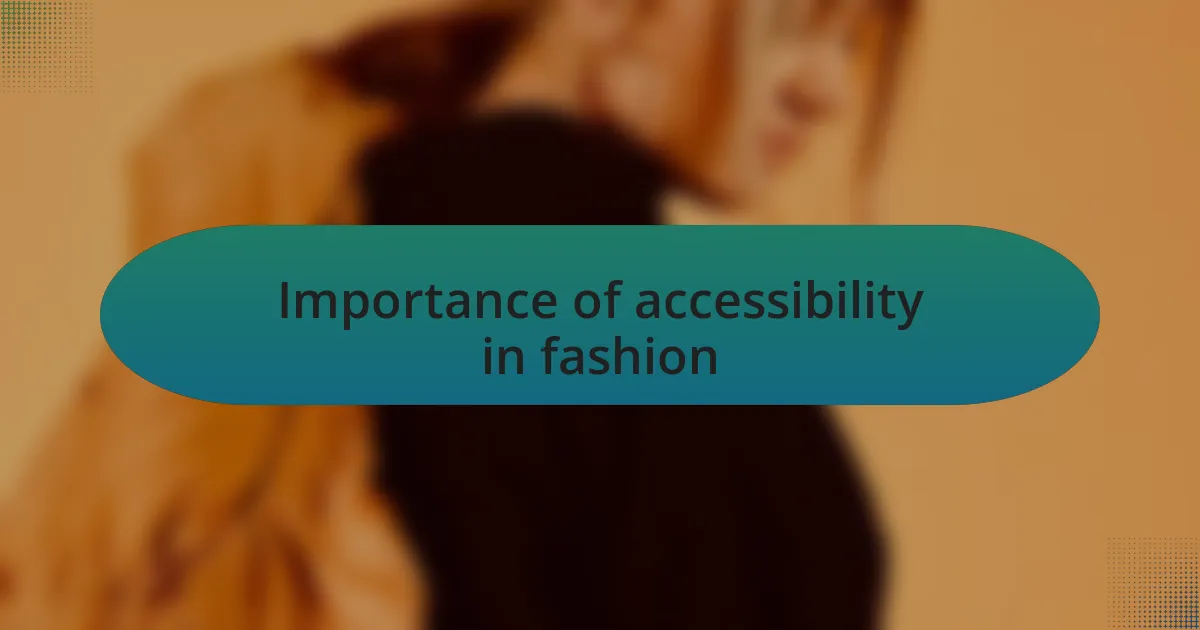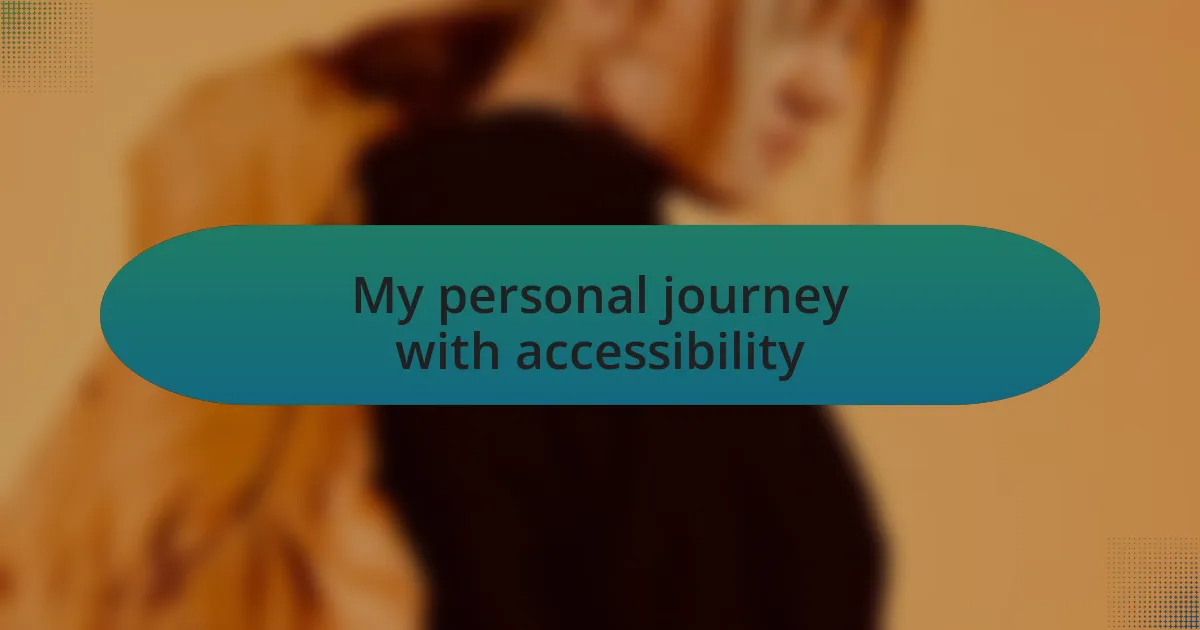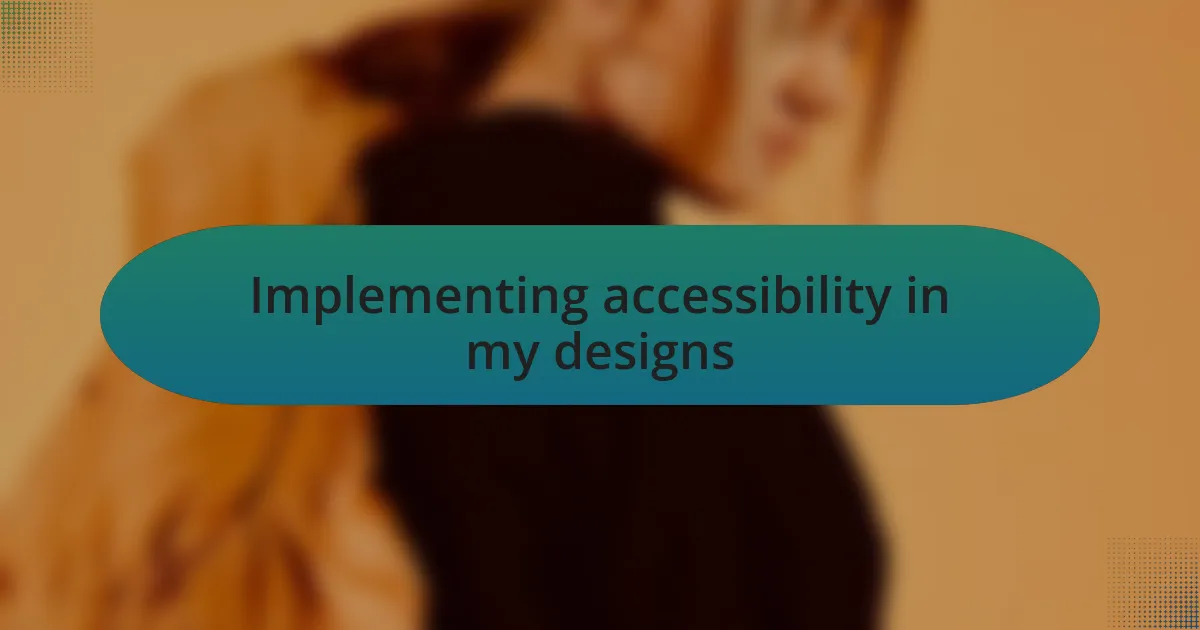Key takeaways:
- Accessibility in design transcends compliance, creating inclusive experiences that empower users with diverse needs.
- Fashion design must consider the needs of individuals with disabilities, fostering innovation and expanding the customer base.
- Key principles of accessible design include clarity, flexibility, and user feedback, ensuring effective engagement for all users.
- Personal experiences highlight the importance of incorporating accessibility in both fashion and web design, emphasizing continuous learning and adaptation.

Understanding accessibility in design
Accessibility in design goes beyond mere compliance with regulations; it’s about creating an inclusive experience for everyone. I remember when I first learned about web accessibility, I was shocked to discover how many people rely on assistive technologies. It made me realize that every choice I make in design can potentially empower or hinder someone’s experience.
Consider how visually impaired users navigate websites using screen readers. I’ve often found myself wondering: how easy is it for them to access content that I take for granted? When I ensure that images have descriptive alt text or that color contrasts are strong enough, I’m not just following guidelines; I’m enabling someone to engage fully with what I create. This personal connection to the design process has reshaped how I approach each project.
Moreover, accessibility challenges us to think creatively. For instance, I recall redesigning a navigational element to be more keyboard-friendly. It was a small tweak, but the satisfaction of knowing that I was removing barriers felt incredibly rewarding. Isn’t it inspiring to know that thoughtful design can transform lives? That’s what truly motivates me to prioritize accessibility in everything I do.

Importance of accessibility in fashion
When I think about the importance of accessibility in fashion, I can’t help but reflect on how many potential customers are left out of the conversation. There was a time when I designed a collection and failed to consider how it could be adapted for individuals with disabilities. I’ll never forget the moment a friend who uses a wheelchair shared their frustration about finding stylish clothing that accommodates their needs. That exchange opened my eyes to the fact that inclusivity isn’t just kind; it’s essential for expanding my audience.
Additionally, accessibility in fashion encourages innovation. It pushes designers to think outside the box and create adaptable styles that cater to diverse body types and physical abilities. I’ve found that when I prioritize functional design elements, such as adjustable waistlines or secure fastenings, the final creation often becomes more versatile. Have you ever noticed how practical designs can resonate with a broader range of consumers? That’s the beauty of accessibility — it invites new possibilities.
On a more personal level, I believe that fashion should empower everyone, regardless of their abilities. I remember attending a fashion show featuring adaptive clothing, and watching models confidently express themselves was incredibly moving. It made me realize that when we prioritize accessibility, we foster a culture of acceptance that celebrates uniqueness. Isn’t that the essence of fashion itself?

Key principles of accessible design
When I consider the key principles of accessible design, the first thing that comes to mind is clarity. A few years ago, while working on a website for a fashion line, I realized how crucial it is for every element—like buttons and text—to be easy to read and navigate. This clarity not only helps individuals with visual impairments but also enhances the overall user experience. Have you ever struggled to decipher a confusing layout?
Another vital principle is flexibility. I once designed a landing page that utilized responsive design to ensure that it looked good on various devices, from smartphones to desktops. The feedback I received from users with different accessibility needs was overwhelmingly positive. It got me thinking: how much do we really consider the diverse ways people interact with our designs? Building a website that adapts seamlessly can make a world of difference, allowing everyone to engage with the content effortlessly.
Lastly, I can’t stress enough the importance of feedback and user involvement in the design process. During the development of my fashion blog, I sought input from individuals with different abilities and backgrounds. Their insights led to modifications that significantly improved the user experience. Isn’t it amazing how a little collaboration can bridge gaps and foster a sense of community? Prioritizing accessibility means continuously learning and adapting, ensuring our designs truly resonate with all users.

Tools for accessible fashion design
When it comes to tools for accessible fashion design, I’ve found that color contrast checkers are indispensable. I had an experience where I used a tool to analyze my color palette for a new collection. It was eye-opening to see how subtle changes could make my designs more legible for individuals with color blindness. Have you ever considered how colors can affect your audience’s experience?
Another crucial tool is screen reader software. I remember testing my blog’s navigation with various screen readers, and it was a game changer. The way content is read aloud can dramatically influence how users interact with a site. It reminded me that every text element needs to be semantically structured and labeled correctly. This is not just about accessibility; it’s about creating an inviting space for every visitor.
Lastly, prototyping tools that allow for accessibility checks during the design phase have been vital in my work. I recall using one such tool during the development of my user interface, where I could simulate various accessibility scenarios. It made me realize how proactive measures could save time and enhance kindness in design. Have you thought about how incorporating accessibility tools from the start can reduce revisions later? It’s all part of creating a truly inclusive environment where everyone feels welcome.

My personal journey with accessibility
When I first dove into the world of fashion design, I didn’t fully grasp the importance of accessibility. I remember attending a showcase where I noticed some attendees struggling to navigate the space due to inadequate lighting and poorly positioned displays. That experience stirred something within me—it became apparent that creating visually appealing designs shouldn’t come at the cost of excluding others. Have you ever felt that nagging sense of responsibility to represent everyone?
As I progressed in my career, I began collaborating with diverse teams and learning about the different challenges faced by those with disabilities. One project aimed at adaptive clothing opened my eyes to the nuances of designing with accessibility in mind. I can still recall the excitement and pride I felt while working alongside someone who relied on a wheelchair; together, we crafted garments that were not only stylish but also functional. It was a moment that reinforced my belief that fashion should empower, not hinder.
The more I explored accessibility, the more personal it became. I truly began to reflect on my own experiences and realizations. I once designed a piece that unintentionally excluded a friend who had visual impairments. That moment of realization hit hard—fashion is a powerful form of self-expression, and every person deserves access to it. It’s a bittersweet reminder, yet it fuels my passion to continue learning and advocating for inclusive design. Isn’t it fascinating how our missteps can ultimately shape our purpose?

Implementing accessibility in my designs
Implementing accessibility in my designs starts with understanding the varied needs of my audience. For instance, I once worked on a fashion line that featured vibrant prints and intricate details, but I quickly realized that the heavy reliance on color could alienate those with color blindness. This was a turning point for me; I began to incorporate patterns and textures to ensure that every piece remained visually engaging, regardless of visual ability.
One of my proudest achievements was creating a lookbook that catered to individuals with different needs. I poured my heart into incorporating tactile elements, like raised patterns and braille descriptions. Seeing a visually impaired friend light up as she explored the book was incredibly rewarding. It was a reminder that fashion can transcend boundaries and connect with everyone—don’t you think that’s what design should truly aspire to?
Accessibility also means striving for inclusivity in sizing and fit. I’ll never forget the moment a colleague shared their struggles with finding fashionable clothing in adaptive sizes. This conversation sparked an idea for a collection that includes a broader range of sizes and adjustable features. It got me thinking—how can we ensure that everyone feels represented? By continuously asking these questions, I remain committed to evolving my designs to embrace all bodies and abilities, because fashion should be for everyone.